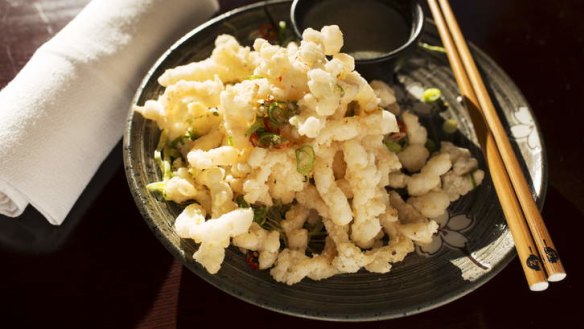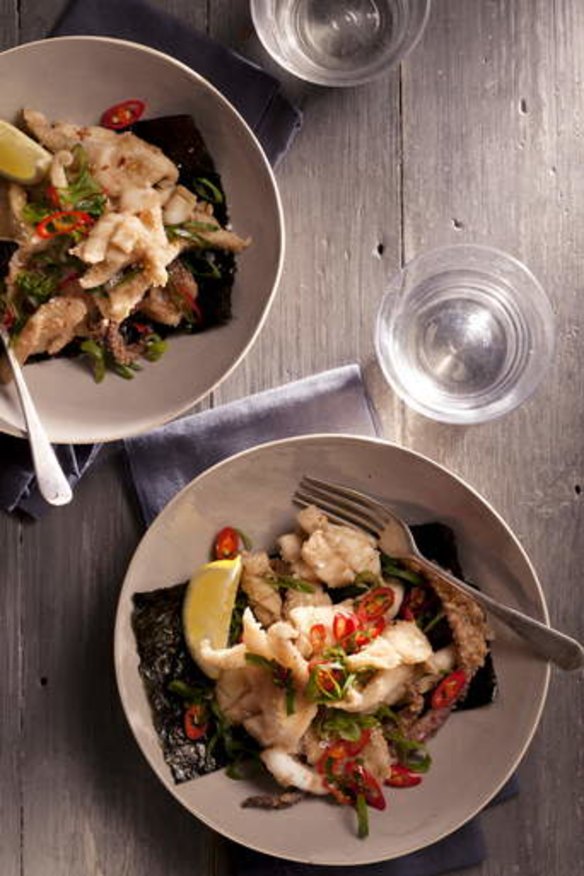How to make the perfect salt-and-pepper squid
Ideal as a starter or snack, it's easy to make this spicy and crisp dish at home.

Sure, there's lemon chicken and honey prawns, but we're suckers for salt-and-pepper squid, in all its crisp, spiced, deep-fried glory.
Ideal as a starter or snack, it's easy to make at home, as long as you don't mind some fast and furious kitchen action.

A bonus is that squid is a sustainable seafood choice, because it grows quickly and breeds prolifically.
There are almost as many versions of this dish as there are cephalopods in the sea, with varying opinions on how one should prepare, batter, season and garnish. Regardless of the recipe, the best salt-and-pepper squid is served straight out of the wok or deep fryer (you want that tongue-searing heat), fried to a light, golden crunch and humming with salty, sweet spice.
Salt-and-pepper squid has its origins in Cantonese cuisine but these days it's scoffed across the world and, here in Australia, it has become a go-to crowd-pleaser.
At Sydney's Red Lantern Vietnamese restaurants, co-owned by chefs Luke Nguyen and Mark Jensen, chilli-salted squid has been inked on the menu since the Surry Hills venue opened its doors 13 years ago.
Nguyen and Jensen (pictured) serve a Vietnamese take on the Cantonese classic and it's their most popular dish.
''There are some things we always keep on the menu and other things we play around with, and salt-and-pepper squid is certainly one we'd have to keep,'' Jensen says.
At lunch and dinner, Red Lantern's chefs commandeer a row of sizzling woks, dropping handfuls of squid tendrils into shimmering oil.
''Thirteen years later, I still want to steal it from people's plates,'' Jensen jokes.
Why so much love for this humble tumble of deep-fried seafood? For Jensen, it ticks all the boxes: ''It's crunchy, it's salty, it's spicy and it's got a really nice mouthfeel and texture to it,'' he says. ''It kind of screams summer or warm weather. Even in the middle of winter, it's like a little escape.''
SQUID TIPS AND TRICKS
According to Jensen, the key to nailing salt-and-pepper squid is using a batter that is crisp but not too firm, ensuring your squid is meaty enough (avoid young squid with a texture that's too fine) and getting the right balance of seasoning.
The squid
It's easy enough to get your hands on some squid tubes or, if you have the time, buy whole squid and clean it yourself. Jensen even consents that frozen calamari rings are acceptable, if you must, but they will give you an inferior result.
When it comes to preparation, you could go for rings or triangles, but the Red Lantern version calls for 5-millimetre-wide strips, because they curl well, have a greater surface area (more batter, more crunch) and, frankly, look pretty. Gently score the squid in a criss-cross pattern to tenderise the flesh and allow it to curl when cooked.
The batter
Lighter batter is better, Jensen says, so Red Lantern uses potato starch, which yields a thinner, crisper coating than other flours. Tossing the squid in beaten egg white before flouring helps bind the batter and makes it even crunchier.
The seasoning
Given the name of the dish in question, you might assume the seasoning was a straightforward matter. Not so. Allegedly the name gets a bit lost in translation - ''salt and spice'' might be more apt. Depending on which school of squid you follow, you might spice things up with black, white or Sichuan pepper; celery salt or chicken stock powder.
The Red Lantern version uses salt, white pepper, Chinese five-spice, ground ginger and white sugar, and the combination packs a satisfying punch.
The garnish
Ignore proponents of the ''lemon wedge only'' approach. The dish isn't complete until you've showered it with fragrant, still-sizzling fried garlic, chilli and spring onion. You'll be picking at these pops of flavour long after the last curl of squid has been devoured.
The frying
Using fresh oil when frying will help you achieve a crisper, lighter batter. To keep the oil clean and the squid pieces separate, use a mesh strainer to continuously strain the oil of excess bits of batter. It's also crucial to keep your oil at a consistent temperature. Too low and the squid will absorb it and not crisp enough. Too high and it will burn. Finally, to add a bit of variety to your life, Jensen suggests using prawn, crab or even chicken wings as an alternative to squid.
Jill Dupleix's recipe for salt-and-pepper squid. Her tip: Get extra crispness by cooking the squid in small batches.
Red Lantern's chilli-salted squid
200g squid tubes, cleaned
vegetable oil, to deep-fry
1 egg white, whisked
150g (1 cup) potato starch
1 spring onion, thinly sliced
1 red bird's eye chilli, thinly sliced
1 small garlic clove, crushed
Salt and pepper seasoning
1 tbsp salt
1 tsp white pepper
1 tsp ground ginger
1 tsp white sugar
1/2 tsp Chinese five-spice
Salt, pepper and lemon dipping sauce
1/2 tsp salt
1 tsp white pepper
2 tbsp lemon juice
1. To make the salt-and-pepper seasoning, combine all the ingredients in a bowl.
2 To make the salt, pepper and lemon dipping sauce, combine all the ingredients in a bowl.
3. Lay the squid tubes on a chopping board. Working from the top of the tubes down to the bottom, run a knife to open them. Score the squid with a criss-cross pattern, cut in half lengthwise, then slice width-wise into five-millimetre pieces. Place in a bowl.
4. Fill a wok or large, deep frying pan one-third full with oil and heat over a high heat to 180C (or until a cube of bread turns golden in 10 seconds).
5. Meanwhile, using your hands, work the egg white into the squid. Gradually add the potato starch, a little at a time, until the squid is well coated and feels quite dry.
6. Shake off the excess flour, then, working quickly with a few pieces at a time, add the squid to the hot oil. Using a slotted spoon, remove and discard any bits of batter that rise to the surface. Cook for three minutes or until light golden and the batter feels firm when tapped with a wooden spoon. Using a slotted spoon, remove the squid and transfer to a colander to drain.
7. Drain the oil from the wok, leaving one tablespoon, and place over medium-high heat. Add the onion, chilli and garlic, toss to combine, then add the squid. Cook for one minute, sprinkling the squid with the seasoning as you cook. Serve immediately with the dipping sauce.
Appears in these collections
The best recipes from Australia's leading chefs straight to your inbox.
Sign up